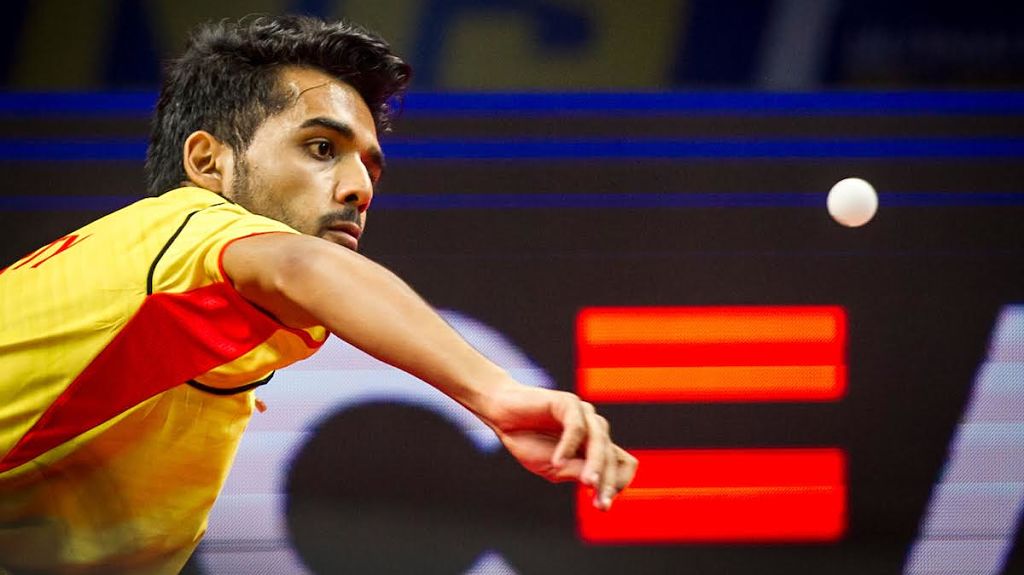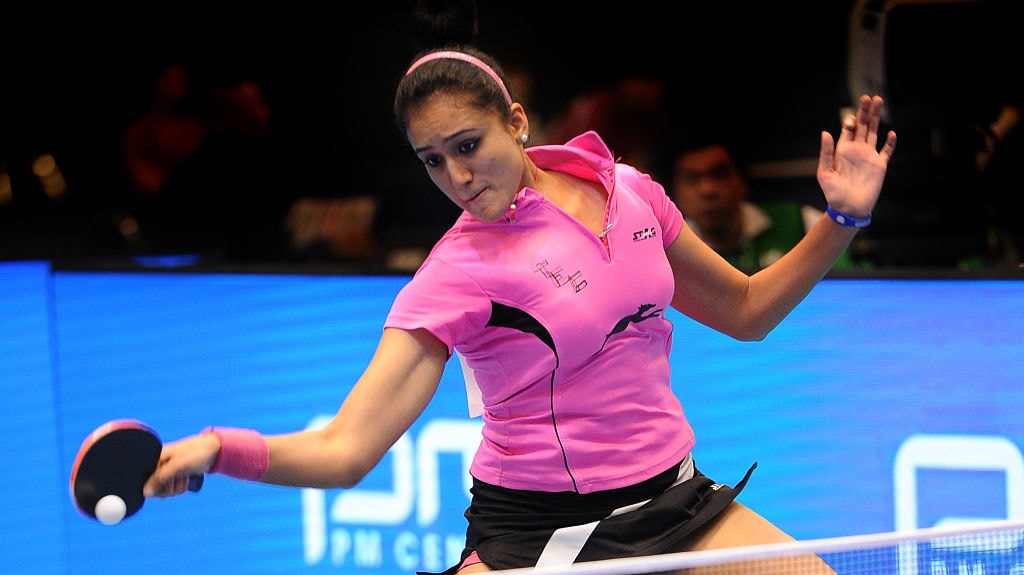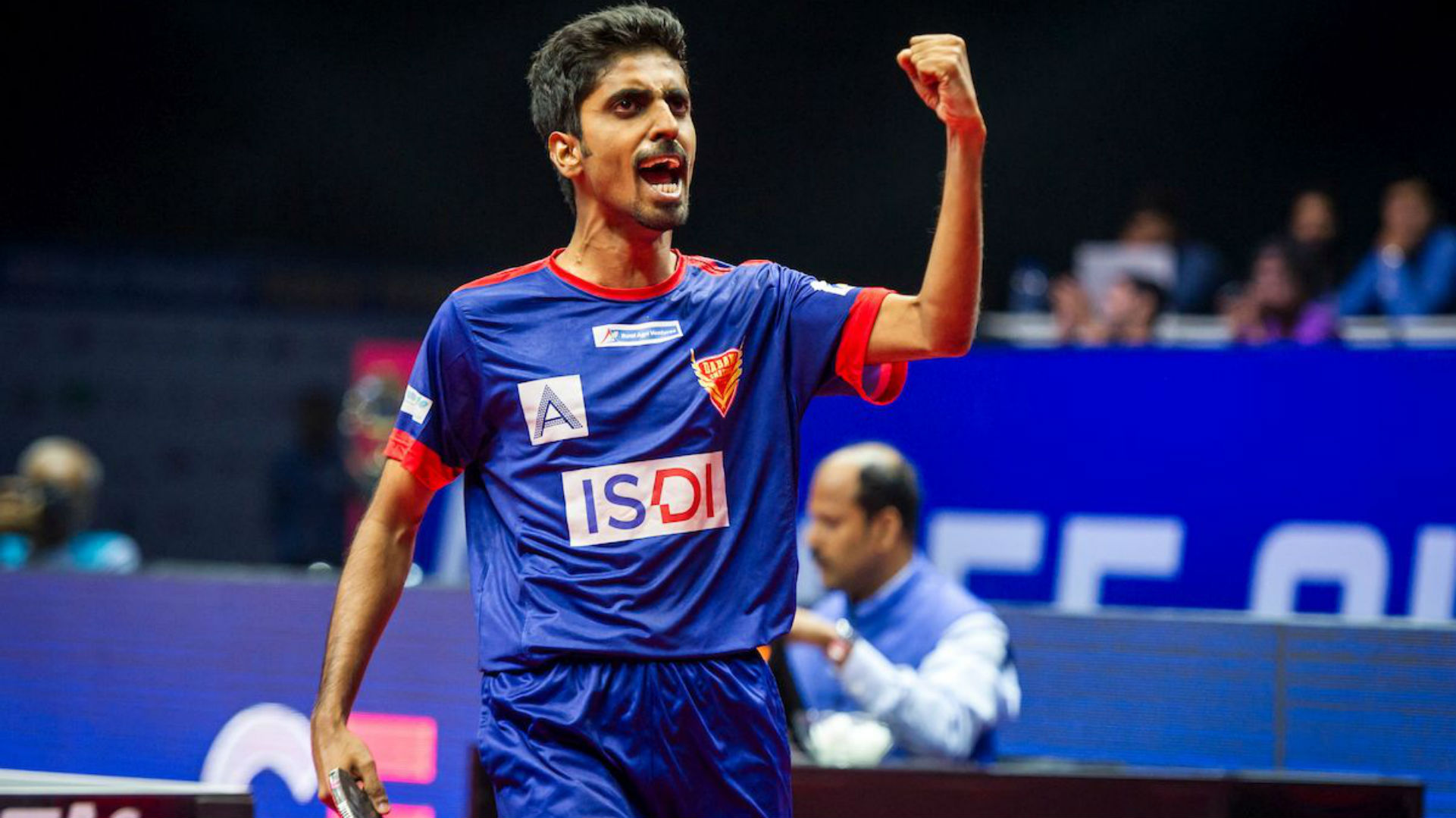Par Gerell, World No 43, reckons an Indian table tennis player will “break into the top 30 or 40” in the world in the next two-three years. Peter Engel, the former Spain, Netherlands and India coach, observed that Indian players “have improved a lot”; a claim which was backed by World N0 27 Petrissa Solja. Wu Yang, World No 13, said the Indian players’ standards were “already high”. Andrej Gacina, ranked 49 in the world, remarked that the current Indian contingent is “quite strong” while former Olympian and ex-women’s coach of Netherlands Elena Timina said the men’s team, in particular, was “surprisingly strong”. Via their performances in Ultimate Table Tennis (UTT), India’s first professional table tennis league, Indian paddlers have left a positive impression on top foreign players and coaches. Aggressive, intense and displaying a fine tactical nous, they beat some top foreign names in the three-week long event. Sathiyan Gnanasekaran stunned world no seven Wong Chung Ting, Manika Batra upset North Korean World No 19 Kim Song I, Soumyajit Ghosh beat Nigerian world No 29 Aruna Quadri while Harmeet Desai outsmarted World No 19 Panagiotis Gionis of Greece, to mention a few. [lq][caption id=“attachment_3919087” align=“alignnone” width=“1024”]
 Relatively unknown names like Sanil Shetty, the ‘foreigner-slayer’, and Sathiyan, the giant-killer, shot into the limelight at UTT[/caption][/lq] Chests were thumped, fists were bumped and some players even went down on their knees or lay flat on the floor in jubilation and disbelief. They signed autographs and clicked selfies with fans – which was earlier reserved exclusively for veteran ace paddler Sharath Kamal. Relatively unknown names like Sanil Shetty, the ‘foreigner-slayer’, and Sathiyan, the giant-killer, shot into the limelight. For a sport that’s been craving recognition and grappling with problems of consistency over the years, UTT has shown that Indian table tennis is finally on the right path. It has witnessed a steady rise in the last couple of years. For the first time, four Indians—Sharath (46), Harmeet Desai (78), Soumyajit Ghosh (86) and Sathiyan (90)— have broken into the top 100 and achieved the feat at the same time. Furthermore, Anthony Amalraj (125) and Sanil (161) are making rapid progress in the international circuit. Sharath’s experience laced with the energy, aggression and fearlessness of the youngsters makes the current lot of players an exciting one. The women too are gradually progressing. “In the last 50 years, this is only time when so many Indians are in and around the top 100,” former India men’s captain and eight-time national champion Kamlesh Mehta told Firstpost. “So that in itself shows it’s a fantastic era (for Indian table tennis). And all these boys are wonderful players and human beings too,” he added. *** In the past year-and-a-half, the sport has taken giant strides in India, even if a surprising one-off blip at the Rio Olympics seems to set it back a little. At the start of 2016, India men’s and women’s team created history when they clinched gold medals in the second division of the World Table Tennis Championships in Kuala Lumpur and earned India a maiden qualification to the champions division, which is the top tier of these Championships. Manika and Mouma Das bagged bronze in women’s doubles of the Czech Open followed by a quarter-final appearance in the Bulgarian Open. Manika’s consistent performances helped her enter the top 100. Sathiyan re-wrote history by becoming the second Indian paddler after Sharath to win an ITTF (International Table Tennis Federation) event by clinching the Belgium Open. Soumyajit also became only the third Indian to win a men’s singles title at an ITTF Challenge Series or ITTF World Tour tournament as he clinched gold at the 2017 Chile Open with a doubles gold being the icing on the cake. Manika-Mouma pairing also reached the quarter-finals of the 2017 World Table Tennis Championships in Dusseldorf, the first Indian pair to do so. “I knew they could play like this but they had been missing a lot of confidence,” Engel, who coached the Indian team in 2013 and 2014, told Firstpost. “However, they have shown now what they can do.”
Relatively unknown names like Sanil Shetty, the ‘foreigner-slayer’, and Sathiyan, the giant-killer, shot into the limelight at UTT[/caption][/lq] Chests were thumped, fists were bumped and some players even went down on their knees or lay flat on the floor in jubilation and disbelief. They signed autographs and clicked selfies with fans – which was earlier reserved exclusively for veteran ace paddler Sharath Kamal. Relatively unknown names like Sanil Shetty, the ‘foreigner-slayer’, and Sathiyan, the giant-killer, shot into the limelight. For a sport that’s been craving recognition and grappling with problems of consistency over the years, UTT has shown that Indian table tennis is finally on the right path. It has witnessed a steady rise in the last couple of years. For the first time, four Indians—Sharath (46), Harmeet Desai (78), Soumyajit Ghosh (86) and Sathiyan (90)— have broken into the top 100 and achieved the feat at the same time. Furthermore, Anthony Amalraj (125) and Sanil (161) are making rapid progress in the international circuit. Sharath’s experience laced with the energy, aggression and fearlessness of the youngsters makes the current lot of players an exciting one. The women too are gradually progressing. “In the last 50 years, this is only time when so many Indians are in and around the top 100,” former India men’s captain and eight-time national champion Kamlesh Mehta told Firstpost. “So that in itself shows it’s a fantastic era (for Indian table tennis). And all these boys are wonderful players and human beings too,” he added. *** In the past year-and-a-half, the sport has taken giant strides in India, even if a surprising one-off blip at the Rio Olympics seems to set it back a little. At the start of 2016, India men’s and women’s team created history when they clinched gold medals in the second division of the World Table Tennis Championships in Kuala Lumpur and earned India a maiden qualification to the champions division, which is the top tier of these Championships. Manika and Mouma Das bagged bronze in women’s doubles of the Czech Open followed by a quarter-final appearance in the Bulgarian Open. Manika’s consistent performances helped her enter the top 100. Sathiyan re-wrote history by becoming the second Indian paddler after Sharath to win an ITTF (International Table Tennis Federation) event by clinching the Belgium Open. Soumyajit also became only the third Indian to win a men’s singles title at an ITTF Challenge Series or ITTF World Tour tournament as he clinched gold at the 2017 Chile Open with a doubles gold being the icing on the cake. Manika-Mouma pairing also reached the quarter-finals of the 2017 World Table Tennis Championships in Dusseldorf, the first Indian pair to do so. “I knew they could play like this but they had been missing a lot of confidence,” Engel, who coached the Indian team in 2013 and 2014, told Firstpost. “However, they have shown now what they can do.”
In the past year-and-a-half, the sport has taken giant strides in India.
Sanil confirms this shift in attitude. “Earlier, when I used to play against a higher-ranked player, I would think ‘well, he is World No 46’. So when I entered the contest, I was almost down and had to go up again when I started.” “But at the 2017 Indian Open, I beat Patrick Baum (World no 15), and then Lubomir Jancarik,” Sanil recalls. “From then, I started gaining confidence to beat higher-ranked players. I started believing in myself. I then won against Benedek Olah, last year’s Nigerian Open champion and then beat World No 13 Jhang Woojin at the Australian Open.” Sanil’s confidence reflected in his play in the UTT league as he defeated World No 29 Aruna Quadri of Nigeria, World No 32 Tiago Apolonia of Portugal and World No 50 Joao Monterio of Portugal. The media attention felt new to Sanil and the Mumbai boy’s every answer was accompanied with a shy, innocent smile. “I played a lot of matches (in the German League); my score was 10-0. You get to learn how to handle pressure playing in front of fans and in crunch situations. These learnings are helping me; I am not feeling the pressure when it’s 10-10 or 9-9. I am just playing my (natural) game.” More and more players are training and playing in foreign events. It was Manjit Dua who started the trend back in 1981-82 when he went to Germany. A desire for global success has slowly trumped the significance of national rankings. “They have been waiting a little too long to go abroad,” Engel opines. “I have been talking to all the coaches who have been working before me. All of us have the same opinion: that you have to go abroad with the national team to work in other countries. It doesn’t matter whether it is Europe or Asia but they should have regular competitions, different partners to play with and only then will they progress.” [imgcenter]
A lot of emphasis was given on breathing positive energy into players’ mindset.
“What I felt they needed immediately was to get a different perception of their capabilities,” Constantini tells Firstpost. “You must develop a perception to be stronger, to compete at the highest level, and you also need talking, mental preparation and continued feedback from players who observe them while playing and see them during their regular life,” Constantini adds. Constantini, who led India to five medals (1 gold, 1 silver, 3 bronze) at the 2010 Commonwealth Games, is of the opinion that there is no dearth of skills in the Indian players but, as he re-iterates throughout our conversation, it’s how you apply those skills which matter the most. “The skills of Mouma (Das) (ranked 135) are the same as others like (Sabine) Winter (ranked 49),” says Constantini. “How they apply their skills differ. So we have to teach them to apply their skills better. To be braver, to take quick decision, to be aggressive when it requires to be aggressive and control when you require them to have to control. “Most of the times, many players, including world-class players, play instinctively and mechanically. They don’t think enough. The player who is able to think faster, better and act properly makes the difference because skills are very similar. Everyone can play forehand topspin, smash, backhand but how they apply is different. So I need to teach them to apply their skills properly.” *** The seeds for a better future were sown way back in 2006 after the Melbourne Games when the government loosened its purse strings with one eye on the 2010 Commonwealth Games at home and strengthened the junior program. Sathiyan, Harmeet, Soumyajit, Amalraj were all a part of this program and products of the Petroleum Sports Promotion Board (PSPB) Academy in Ajmer, the so-called nursery of table tennis which was started in 1996. Getting to rub shoulders with the seniors was a crucial learning curve. Harmeet termed it as one of the turning points of his career. Sathiyan, Harmeet, Soumyajit and Saha were members of the Indian team that won a historic bronze in World Junior TT Championships in Bahrain in 2011. Over time, these kids graduated to the next level and now form the core of the Indian team along with the experienced Sharath. What makes this group special is the strong bond they hold even in the midst of cut-throat competition. [imgcenter]
 While the women paddlers too are progressing, there is a need to press the accelerator.[/caption][/rq] “This is what exactly the girls are missing. They are not as courageous as the boys to leave the country,” says Engel. This is the next step they need to take. Earlier they go, earlier they learn which makes the future much easier,” the former India coach adds. “The self belief system has to go up,” believes Soumyadeep Roy, former India player and coach of UTT champions Falcons TTC. “I think they are not inferior to anyone else. It’s just the practice and the system they have to imbibe” At the UTT, the Indian women paddlers grew in confidence as the league progressed. Elena Timina, former Netherlands women’s coach and Shaze Challengers’ coach described Indian women’s level as “quite good” but fitness remained a concern. “They have to get fitter. Some of them like Mouma and Manika are very fit but the other girls are a bit overweight,” Timina told Firstpost. Fitness is in focus as an area of improvement for men too. Constantini describes it as “acceptable” while Engel termed it as “quite better” with room for improvement. *** Alongside, technical aspects of the game need to be sharpened as well. “I think what we are lacking now is in our serving,” says Constantini. “We need to improve upon our serve because serve can give you the initial advantage in a point. We don’t win points directly with serves but nine out of 10 times you lose the point if you don’t start well,” the Indian coach adds. “In an open game, (Indian players) are very good but serving and receiving are very important aspects and if they can improve this, they will become better,” Gacina concurs. World No 60 England’s Liam Pitchford who was a part of Falcons TTC says that the main area of for improvement “is the short game”. In the rallies, he says, “they can compete against everybody.” Timina is of the opinion that the women have to play with a little bit of variation. “They have one style, which is good but if you get an answer to that then it’s very difficult to change something. And they obviously really have to learn to play against a defensive player.”
While the women paddlers too are progressing, there is a need to press the accelerator.[/caption][/rq] “This is what exactly the girls are missing. They are not as courageous as the boys to leave the country,” says Engel. This is the next step they need to take. Earlier they go, earlier they learn which makes the future much easier,” the former India coach adds. “The self belief system has to go up,” believes Soumyadeep Roy, former India player and coach of UTT champions Falcons TTC. “I think they are not inferior to anyone else. It’s just the practice and the system they have to imbibe” At the UTT, the Indian women paddlers grew in confidence as the league progressed. Elena Timina, former Netherlands women’s coach and Shaze Challengers’ coach described Indian women’s level as “quite good” but fitness remained a concern. “They have to get fitter. Some of them like Mouma and Manika are very fit but the other girls are a bit overweight,” Timina told Firstpost. Fitness is in focus as an area of improvement for men too. Constantini describes it as “acceptable” while Engel termed it as “quite better” with room for improvement. *** Alongside, technical aspects of the game need to be sharpened as well. “I think what we are lacking now is in our serving,” says Constantini. “We need to improve upon our serve because serve can give you the initial advantage in a point. We don’t win points directly with serves but nine out of 10 times you lose the point if you don’t start well,” the Indian coach adds. “In an open game, (Indian players) are very good but serving and receiving are very important aspects and if they can improve this, they will become better,” Gacina concurs. World No 60 England’s Liam Pitchford who was a part of Falcons TTC says that the main area of for improvement “is the short game”. In the rallies, he says, “they can compete against everybody.” Timina is of the opinion that the women have to play with a little bit of variation. “They have one style, which is good but if you get an answer to that then it’s very difficult to change something. And they obviously really have to learn to play against a defensive player.”
Exciting times lie ahead for Indian table tennis.
This has been a challenge for Indian paddlers. With players preferring aggressive styles, there’s a paucity of defensive players in the country to play or practice against. Constantini, in fact, moved to sanction the name of Mizoram’s Lalrin Puia, a defensive player, as the team’s sparring partner for the Asian Championships this year. “We have to give opportunity to our players to practise against choppers,” Constantini says. “We had never done this before. We have a few defensive players in India and we need to involve them in our program. Because playing against choppers is a must. (Puia) was very very helpful for us,” Constantini adds. The talent was always there. Today, the guidance is there and the technique is improving. There’s no dearth of hard work either. Constantini wants to take the Indian paddlers to the next level. The youngsters want to be on the Olympics podium in the next four to eight years. The main focus today is the 2018 Commonwealth Games and Indian table tennis seems to be heading in the right direction. “I am very happy because we are definitely on the right track. The UTT league is giving them the final confirmation of what they are capable of,” Constantini beams. The current era has impressive cluster of talent. And Engel acknowledges it too: “These (Indian) players have no limit on the upward curve.” Exciting times lie ahead for Indian table tennis. There are plenty of reasons to be positive about the sport. ‘Up the game’ was a slogan floated around in the Twitter hashtags during the first Ultimate Table Tennis league. The Indian paddlers have upped their game indeed.
)